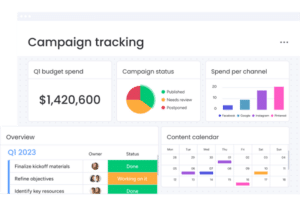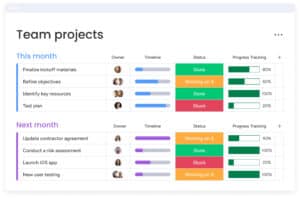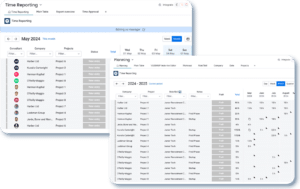Introduction
In the bustling world of project management, where every tick of the clock counts, the key to unparalleled productivity might just lie in a methodical approach known as time-blocking. Incorporating time-blocking strategies to enhance project productivity isn’t just a trend. It’s a transformative practice that redefines how we view and manage our most precious resource – time.
Imagine a world where deadlines aren’t daunting, and the chaos of multitasking is replaced by a serene focus. This is the world time-blocking promise. Incorporating time-blocking strategies to enhance project productivity isn’t a mere rearrangement of tasks. It’s about architecting your day, piece by piece, to create a masterpiece of efficiency and effectiveness. By allocating specific time slots to individual tasks or groups of tasks, time-blocking empowers project managers and team members alike to work with clarity and purpose. Previously, this has been obscured by the fog of constant interruptions and shifting priorities.
But how exactly does incorporating time-blocking strategies enhance project productivity? It boils down to the psychology of work. When we dedicate chunks of time to specific activities, we fence off distractions, sharpen our focus, and create a rhythm that elevates both the quality and speed of our work. This introduction will guide you through the essentials of time-blocking. Additionally, it’ll reveal how this simple yet powerful technique can be the catalyst for remarkable improvements in your project’s productivity.
As we delve deeper into the nuances of time-blocking, remember, it’s not just about filling your calendar with blocks of tasks. It’s about strategically designing these blocks to align with your project goals, team dynamics, and personal work style. The goal of incorporating time-blocking strategies to enhance project productivity is to transform how you approach your work. This leads to a more structured, efficient, and ultimately successful project execution.
Understanding Time-Blocking
Time-blocking, at its core, is a time management method that involves dividing your day into blocks of time, with each block dedicated to accomplishing a specific task or group of tasks. This technique moves beyond traditional to-do lists by assigning a specific ‘when’ to the ‘what’. Incorporating time-blocking strategies to enhance project productivity starts with understanding that it’s more than just a scheduling tool. It’s a mindset that encourages discipline and focus. Each block acts as a mini-deadline, helping to keep the project on track and ensuring that each task receives the attention it deserves.
Benefits of Time-Blocking in Project Management
The benefits of incorporating time-blocking strategies to enhance project productivity are manifold. Firstly, it aids in prioritizing tasks, ensuring that critical project milestones are given the attention they require. This method also helps in combating the pitfalls of multitasking, which often leads to decreased quality and increased stress. By dedicating specific time slots to tasks, team members can dive deep into their work without the constant interruption of switching tasks. Furthermore, time-blocking provides a clear roadmap for the day, reducing the time spent on deciding what to do next. This clarity not only boosts productivity but also enhances team communication. This is because everyone is aware of their responsibilities and when they are supposed to deliver.
The Psychology Behind Time-Blocking
Incorporating time-blocking strategies to enhance project productivity is deeply rooted in the psychology of work. By setting aside defined periods for focused work, individuals create a structure that psychologically prepares them to engage in a task. This boundary setting helps in reducing decision fatigue and procrastination, common challenges in project management. Time-blocking also promotes a state of ‘flow’. This is a psychological concept where individuals are fully immersed and engaged in the task at hand. As a result, this leads to higher productivity and satisfaction. Understanding this psychological aspect is crucial in effectively incorporating time-blocking into your project management toolkit.
Omnitas Newsletter
Sign up for our monthly newsletter to stay up-to-date on our latest blog articles, videos and events!
Thank you!
You have successfully joined our subscriber list.
Implementing Time-Blocking in Your Projects
The first step in incorporating time-blocking strategies to enhance project productivity is to identify the time blocks that will structure your day. This involves a thorough analysis of the project tasks, understanding their priority and estimated time for completion. Start by breaking down the project into smaller, manageable tasks. Then, estimate how much time each task will require. Remember, it’s vital to be realistic in your estimations to make your time blocks effective. Consider also the best time of the day for certain tasks based on team members’ energy levels and availability. For instance, creative tasks might be best scheduled for when the team is most alert and fresh.
Scheduling Your Time Blocks
Once you’ve identified the tasks and estimated their duration, the next step in incorporating time-blocking strategies to enhance project productivity is to schedule these blocks into your calendar. Tools like monday.com can be exceptionally beneficial here, offering visual and interactive calendars that make scheduling more efficient. When scheduling, consider the natural workflow of the project and the dependencies between tasks. Allocate time blocks for deep work – tasks that require intense focus – during periods of least interruption. It’s also important to schedule breaks and buffer times between blocks to handle unforeseen tasks or overflows.
Communicating Time Blocks to Your Team
Effective communication of these time blocks to your team is a crucial aspect of incorporating time-blocking strategies to enhance project productivity. Ensure that every team member is aware of their time blocks and understands the importance of respecting these blocks. Utilize project management tools to share schedules and make them visible to all. This transparency helps in aligning team efforts, reducing conflicts over resource allocation, and ensuring that everyone is on the same page. Regular check-ins can be scheduled to discuss the effectiveness of the time blocks and make adjustments as needed.
Time-Blocking Strategies for Different Project Stages
Initiation and Planning
In the initiation and planning stages of a project, incorporating time-blocking strategies to enhance project productivity is crucial. These early stages require focused time for brainstorming, researching, and setting clear goals and objectives. Time blocks should be allocated for team meetings, stakeholder discussions, and the development of project plans and schedules. It’s important to block out ample time for these activities, as they lay the foundation for the entire project. During this phase, flexibility is key, as plans may need to be adjusted frequently based on new insights and feedback.
Execution and Monitoring
As the project moves into the execution and monitoring phase, the focus of incorporating time-blocking strategies shifts to maintaining productivity and momentum. This stage requires blocks of time dedicated to core project activities, regular team check-ins, and monitoring progress against the project plan. Time blocks can be used to schedule specific tasks, such as development work, content creation, or data analysis. This ensures that each critical component of the project receives focused attention. Additionally, regular time blocks should be set aside for reviewing progress, identifying any issues or bottlenecks, and adapting the project plan as necessary.
Closing and Evaluation
In the final stages of the project, incorporating time-blocking strategies is essential for ensuring a smooth wrap-up and evaluation. Time blocks should be allocated for finalizing project deliverables, conducting post-project reviews, and documenting lessons learned. This is also the time to recognize team efforts and contributions. Allocating specific time to these activities ensures that they are conducted thoroughly and do not get overlooked in the rush to move on to the next project. It’s a crucial step in enhancing overall project productivity and success, providing valuable insights for future projects.

Overcoming Common Challenges in Time-Blocking
Avoiding Overcommitment
One of the key challenges in incorporating time-blocking strategies to enhance project productivity is avoiding the trap of over-commitment. It’s easy to fall into the habit of packing your schedule with back-to-back tasks. This leaves no room for breaks or unexpected demands. To avoid this, it’s crucial to be realistic about how much can be achieved in each time block. Allow for buffer times between blocks to handle any spillover or unplanned tasks. It’s also important to regularly review and adjust your time blocks to reflect the actual pace of work and to prevent burnout. Remember, effective time-blocking is about quality, not just quantity.
Dealing with Interruptions
Another common challenge in incorporating time-blocking strategies is managing interruptions, which can derail even the best-laid plans. To minimise disruptions, communicate your schedule to your team and set clear boundaries when you are in a time block dedicated to focused work. Make use of tools and techniques to minimise distractions, such as turning off notifications or working in a quiet environment. Additionally, consider scheduling specific time blocks for dealing with emails, calls, and other potential interruptions. This is so they don’t interfere with your focused work time.
Adapting to Changing Priorities
Projects are dynamic, and priorities can shift unexpectedly, posing a challenge to your time-blocking schedule. The key to successfully incorporating time-blocking strategies to enhance project productivity in such situations is flexibility. Be prepared to adjust your time blocks as new priorities emerge. This may involve shortening some blocks, extending others, or even rescheduling tasks to a later date. Regularly revisiting and revising your time-blocking plan is essential to ensure it aligns with the current project demands and team capacity.
Conclusion
Incorporating time-blocking strategies to enhance project productivity is more than a mere scheduling technique; it’s a transformative approach that redefines how we manage our time and execute tasks. Throughout this blog, we’ve explored the myriad benefits of time-blocking, from fostering focused work and reducing stress to improving overall project efficiency. We’ve also navigated through the different stages of a project, adapting time-blocking strategies to each phase for optimal results. Moreover, we’ve tackled the common challenges that come with this method, providing solutions to ensure its successful implementation.
The key takeaway is that time-blocking is not a one-size-fits-all solution; it’s a flexible and dynamic tool that can be tailored to fit the unique needs of each project and team. By consistently incorporating time-blocking strategies, project managers and teams can not only enhance their productivity but also create a more structured, stress-free work environment.
As we conclude, it’s important to remember that the journey to mastering time-blocking is a continuous one. It requires regular evaluation and adaptation to find the perfect balance for your team and projects. Whether you’re managing a small team or steering a large-scale project, the principles of time-blocking can be a game-changer in how you approach your work.
If you found this blog post useful, make sure to sign up for our monthly newsletter below. Stay in the loop regarding all things business efficiency and automation!
























